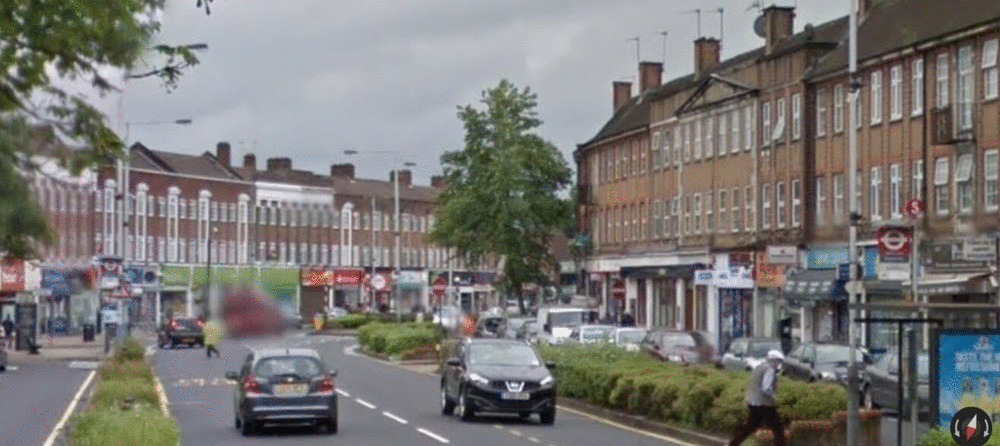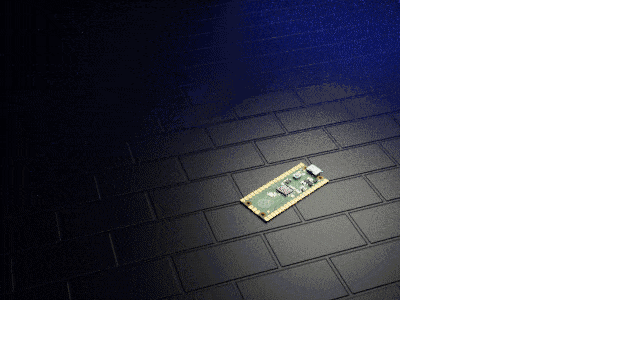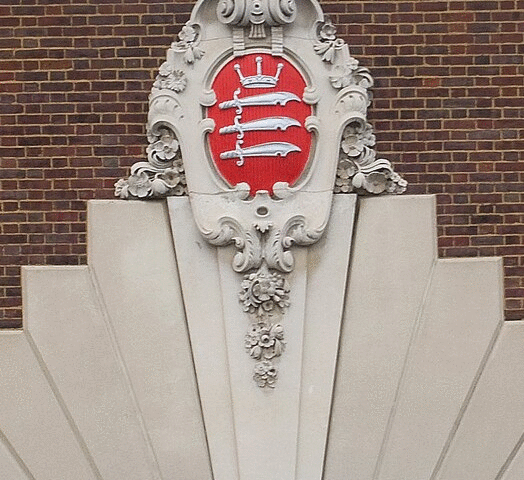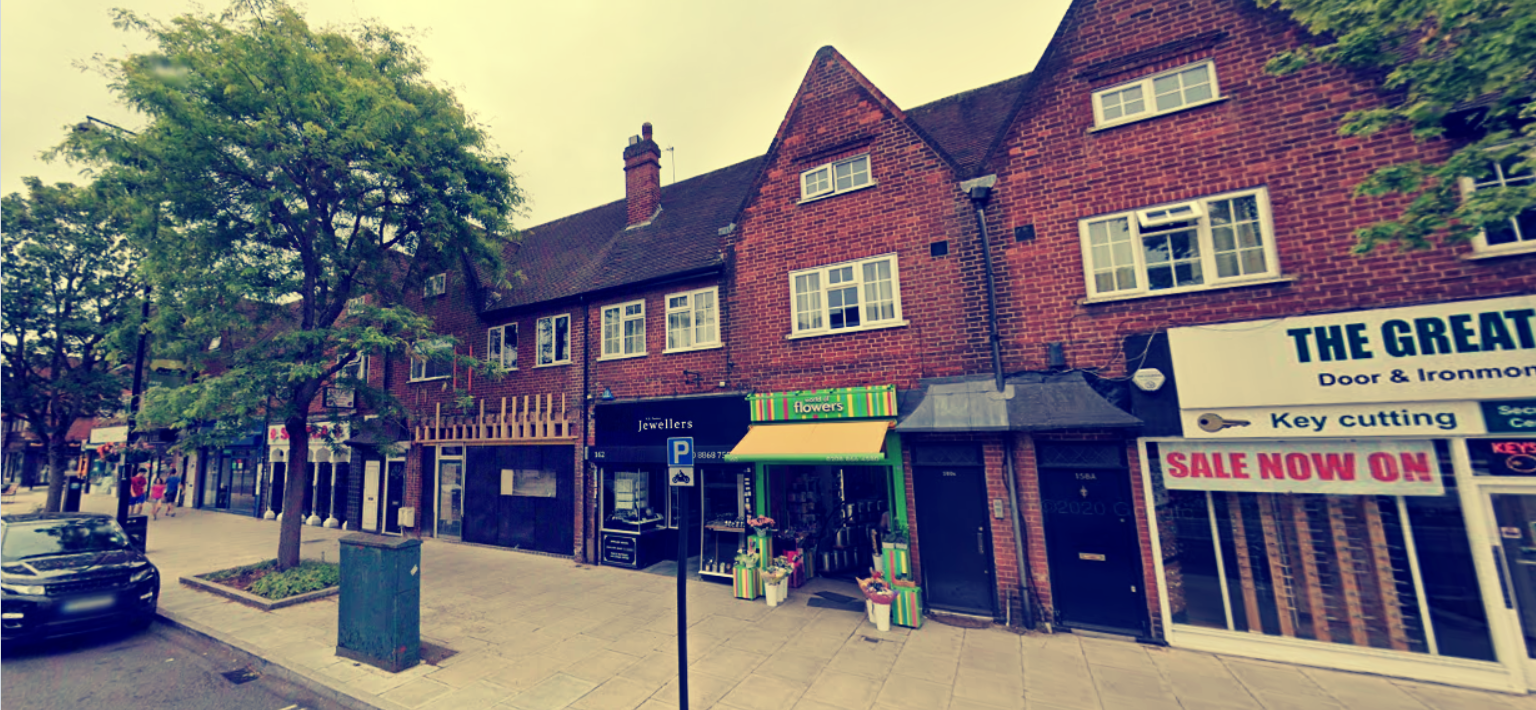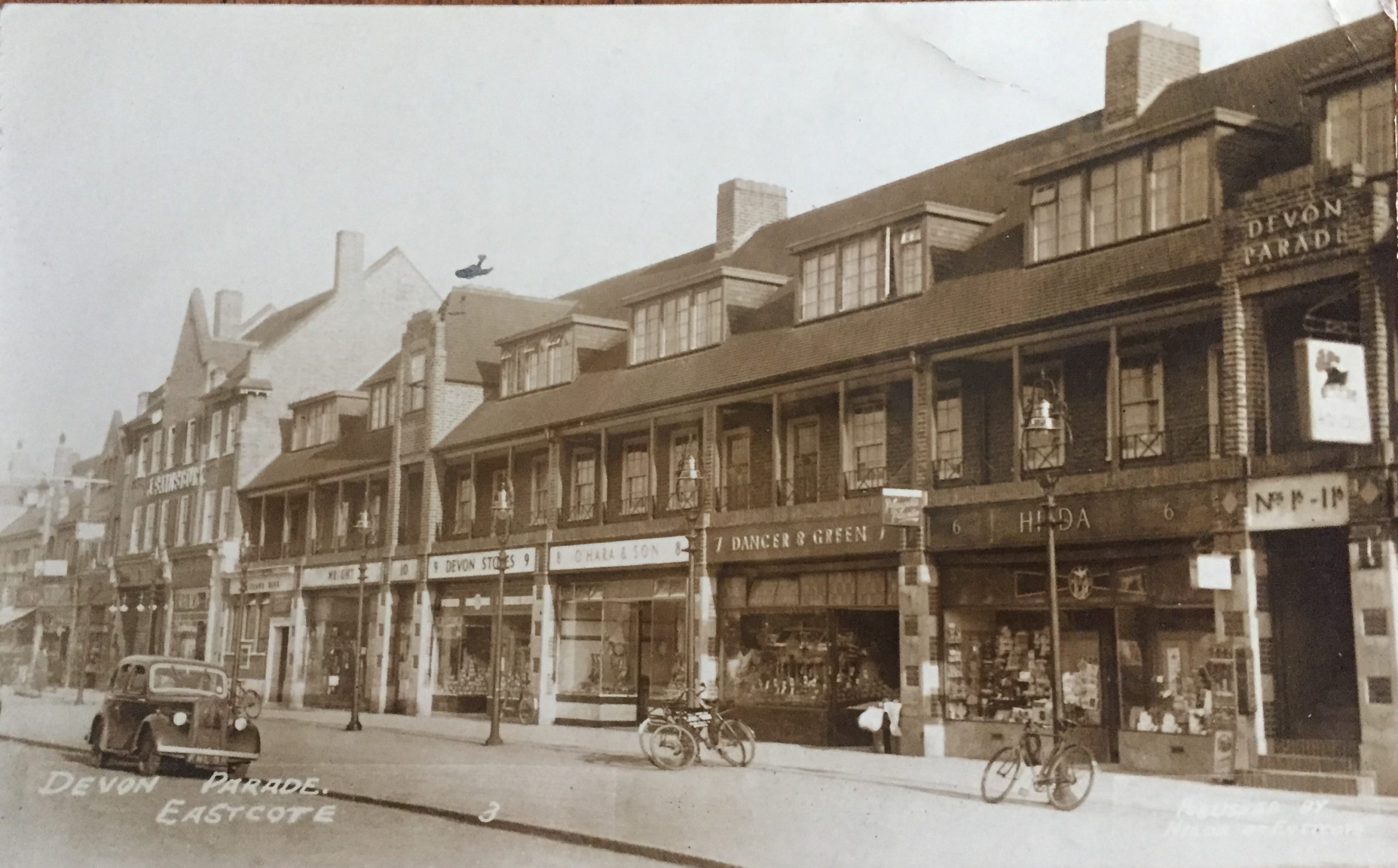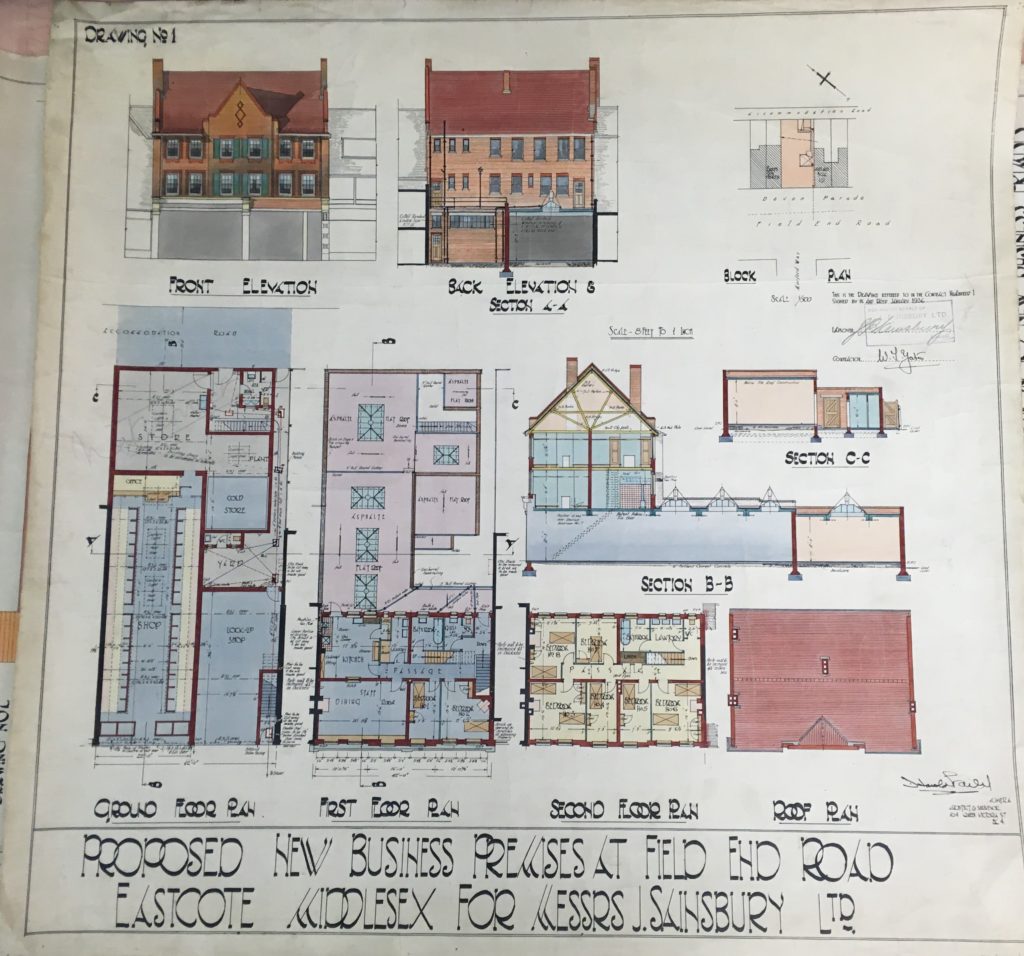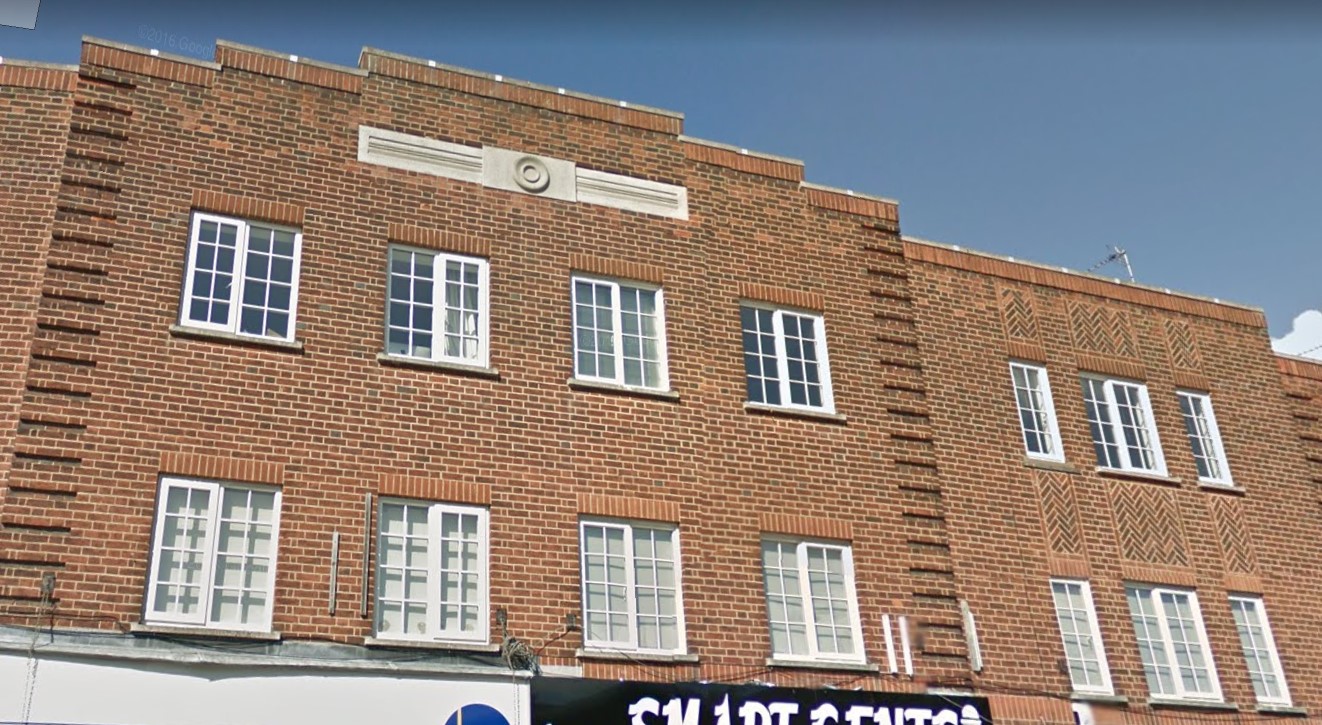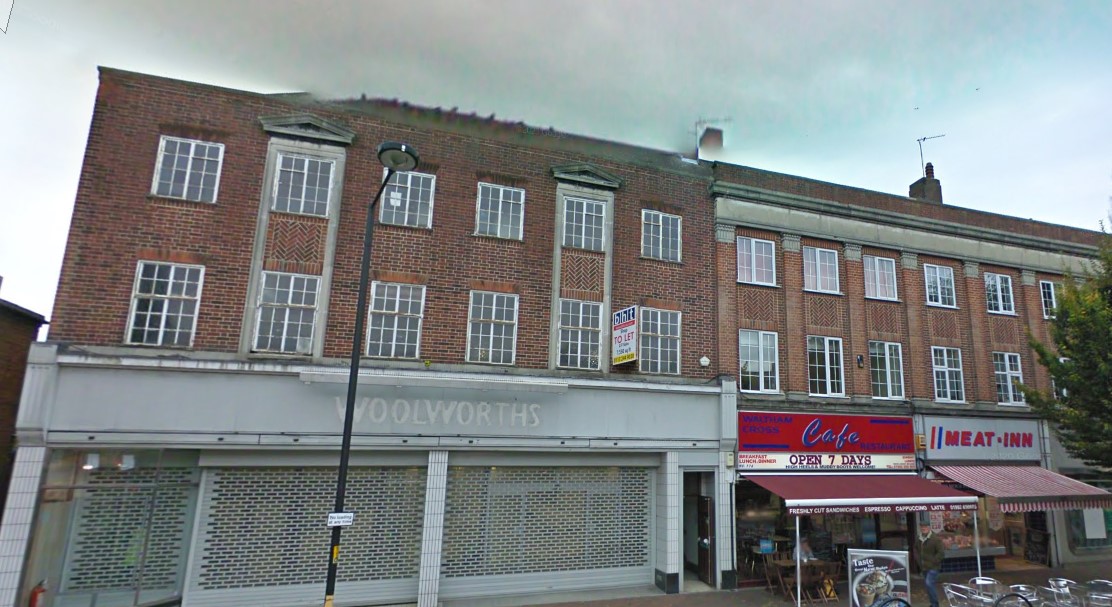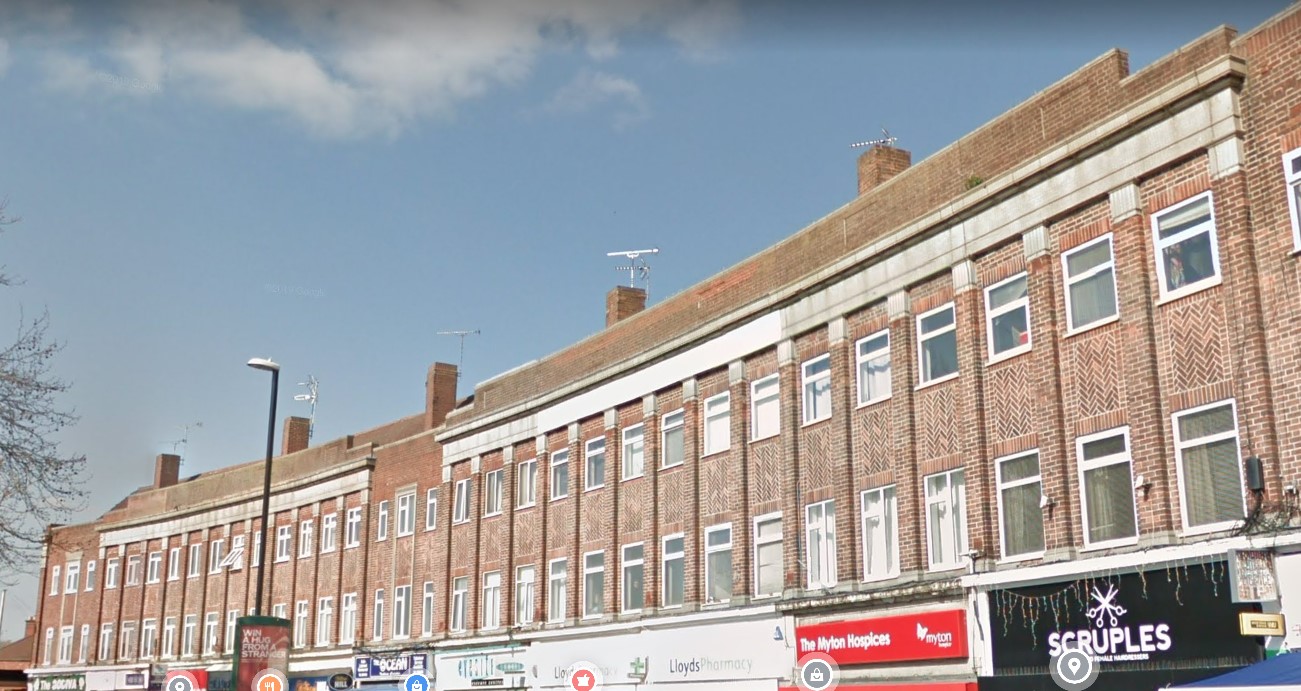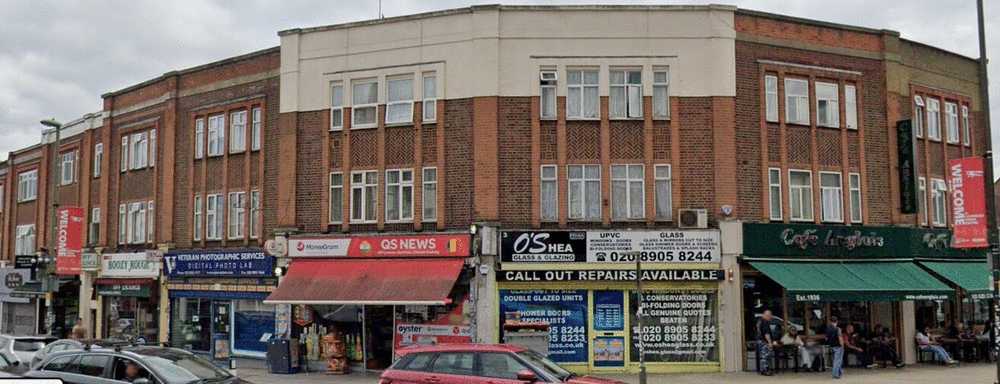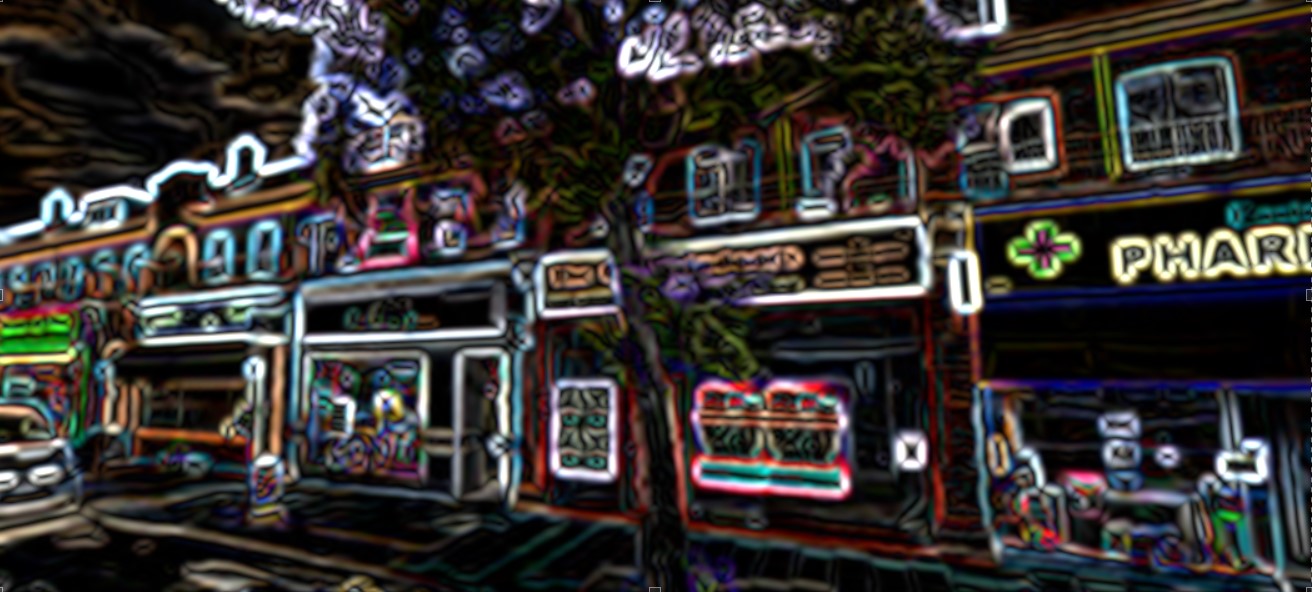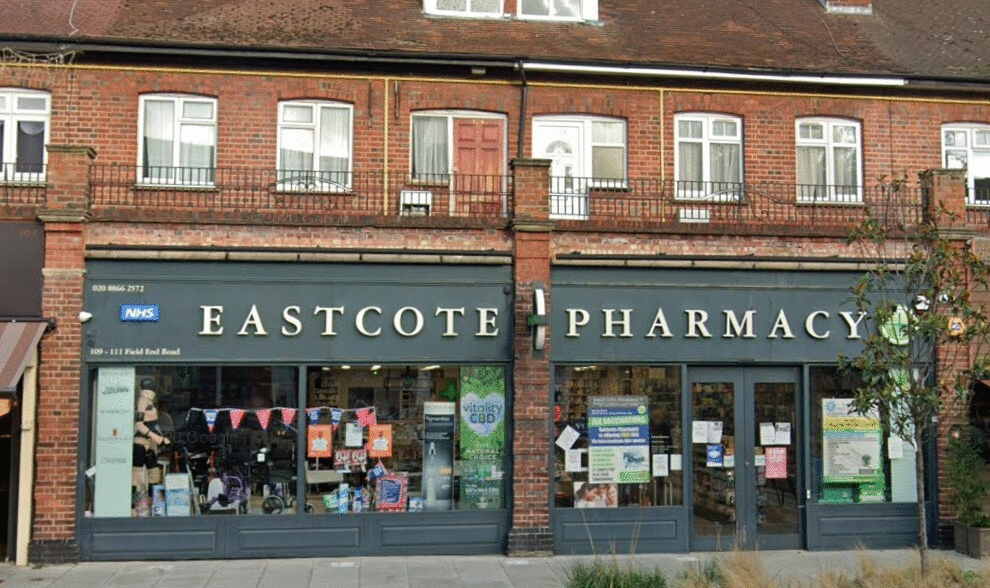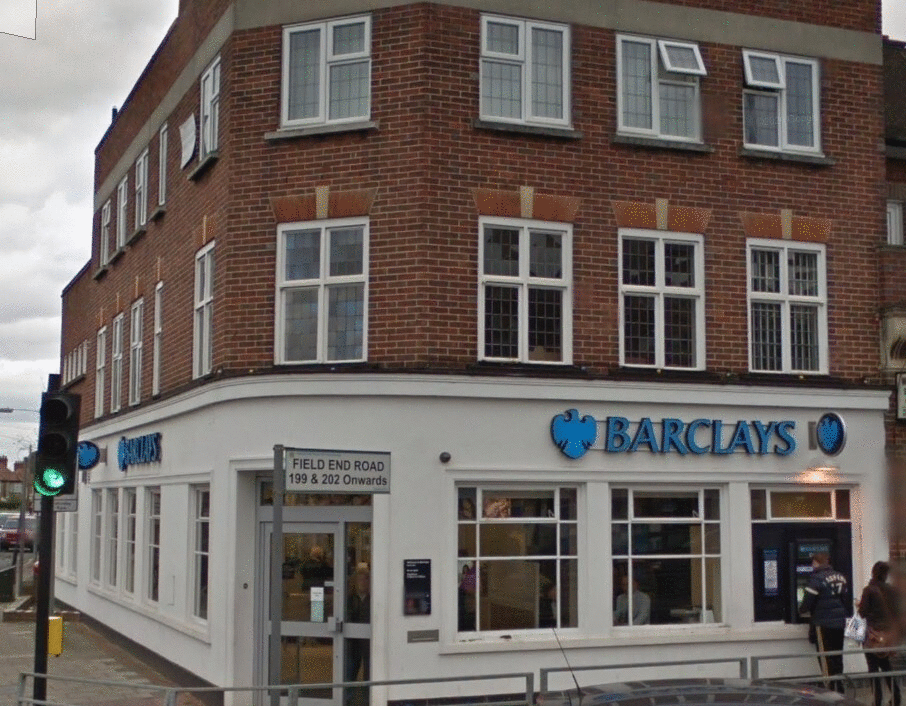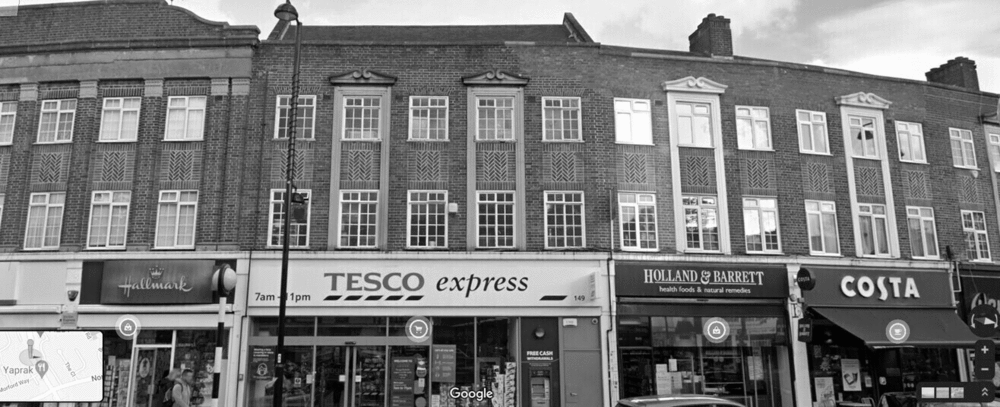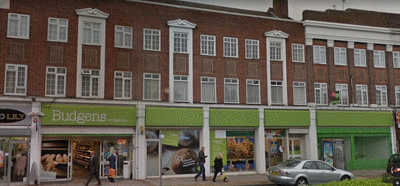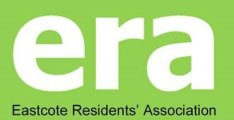Eastcotes Shopping Parades . There is a comprehensive article in the RNELHS Journal 1998 The Development Of The Retail Trade In Eastcote by Ron Edwards but here there are some more details. When the shops in Field End Road were being built, most blocks were given individual parade names. The first of these was Field End Parade, built in the mid-1920s, and extending from what is now the Micromax Repair Centre to Champers Bar on the west side of the road. Others followed suit, including Deane Parade, Devon Parade, Queens Parade, Telcote Parade and Orchard Parade. Evidence of their existence has virtually disappeared now but, if you look above Robert Cooper estate agents premises on the corner of Elm Avenue, you can still see a plaque bearing the name Queens Parade.
Fig 3 Orchard Parade . ©Google2021 aerial view travelling south from Eastcote Library to the Ascot Pub and beyond to Field End Parade. RNELHS Journal 2004 says that the shops on the opposite side of Field End Road were developed at different stages by Rotherham Estates as was Orchard Parade as far as the shop that used to be the post office. During World War Il this was used as a British Restaurant which provided low-cost meals. The rest of the parade was completed in the fifties, ending with Eastcote Library in 1959. The Deane Parade opposite was built by T.F.Nash. Information has been extracted from a range (but incomplete set) of Kelly’s street directories between 1954 and 1977, supplemented by details from electoral rolls. The flats above Orchard Parade are not shown as occupied until the 1945 – the electoral roll was published in August of that year. It ran from next to The Ascott as far as the left-hand side of the Nat West Bank.Figure 5 Orchard Parade North Corner . Eastcote Library bears the Middlesex Shield/Escutcheon and is dated 1959. The figure also shows The Middlesex shield; on the aqueduct over the North Circular Road © Rod Allday , in stain glass at Uxbridge tube station © Mattbuck, Park Royal tube station © Copyright Mike Quinn, in cartouche at Middlesex University © Copyright Julian Osley all licensed for reuse under Creative Commons Licence . The Coat of Arms assigned to the Kingdom of the Middle and East Saxons depicted three “seaxes” An addition in 1910 was the “Saxon Crown” derived from the portrait of King Athelstan on a silver penny of his reign stated to be the earliest form of crown associated with any English sovereign. The modern word Middlesex word is formed from the Old English , ‘middel’ and ‘Seaxe ‘Wiki Wiki explains that seax means a type of small sword, typical of the Germanic peoples of the Migration period and the Early Middle Ages especially the Saxons. The word Saxon derives from seax. The seax is used in the Arms of Brent, Hounslow and Essex . Wiki describes the South Saxons, the East Saxons and the West Saxons . Might this be the why the Arms bears three seaxes? As a County, Middlesex lives on. ‘….there are vestiges of loyalty to the name, especially among army men. Many now living have been proud to belong to the ‘Die-Hards’, thus named after their conduct at the Battle of Albuera in 1811 that is to say the 57th Foot of 1782, known as the Middlesex Regiment… p.15 (c) Bruce Stevenson Middlesex 1972 Pub T Batsford. (The shield is 85m from the Eastcote War Memorial.) The land on which the parade was built was formerly an orchard, hence the name. By the time the extension to this parade (up to no. 90 Field End Road, next to the library) had been constructed by around 1955, individual parade names had been dropped as shops were numbered in the main Field End Road sequence. Original parade numbers and establishments where known, are taken from the 1954 Kelly’s directory (the first post-war directory), with their current numbers in brackets. The shops in the extension of the parade are shown from Kelly’s 1958 directory.Fig 7 Field End Parade (© Google 2019) on the west side of the road, straddling Morford Way and extending from the current tiny taxi office at one end to the computer, etc. repair shop at the other. The parade was built between 1924 and 1926; the original parade numbers and shops are listed below with their current numbers in brackets. The information dates from the 1929 to 1939 editions (two are missing) of Kelly’s street directories for the area. 1a [184a] is first listed from 1933 as a boot repairers, run by Joseph Rowe Cook & Son. 1 [184] was a drapers, run by the Misses Clements (later Miss Hilda Clements). 2 [182] was a chemists, managed by Alex Cargill Bowden as was 2a, a hairdressers; by 1930 both nos. 2 and 2a were Maison Henri, a hairdressers, the proprietor being John Clark Bewlay (see also no. 7). From 1934 Reginald Thomas Burgess is listed as the hairdresser at no. 2 and as Burgess Ltd. in 1939. 3 [180] was a beer retailers, run by Mark William Stopps, later described as a wine merchant. His telephone number was Pinner 572. By 1939 it was the Westminster Wine Co. Ltd. 4 [178] was a confectioners, run by E & F Wheeler, from 1931 by Mrs Ethel May Coles and later (1936) described as E M Coles & Son(s). 5 [176] was the grocers Howard Roberts Ltd. 6 [174] was a fruiterers, run by Robert John McKay. Morford Way is here 7 [172] was, from 1930, the chemists run by Alex Cargill Bowden, relocated from no. 2; by the following year it was managed by Thomas Theodore Johnson and from 1933 was also a sub-post office. 8 [170] was a bakers, run by George Clarkson; by 1933 it was managed by Henry Lionel Wilton. 9 [168] is first listed in 1930 as Douglas (Ironmongers) Ltd and as Fox & Stride [Frederick William Fox and Cecil Stride], ironmongers, from 1934. 10 [166] was a fishmongers, run by Charles John Stephens. 10a [166a flat] is listed, in 1933 and 1934 only, as Sherrot, Hunt & Co., chartered accountants. 11 [164] was a butchers, run by Leslie George Clibbens; by 1936 it was managed by Bernard E Nash. 12 [162] was an art needlework store, managed by Miss Lilian Whyley Key. 12a [160] is listed, from 1933 to 1934, as C M [Charles Martin] Robarts & Son (Park Farm dairy); from 1937 it was a cooked meats shop, run by Stanley John Harris. There is no match up occupancy with the last three parade numbers, 13 to 15. The current no. 154 Field End Road seems to have been two separate premises. 13 [158] was, from 1937, a boot repairers, run by Jack Holland. 13a [156] was, from 1938, the watchmakers C S Bedford. 14 [154] was the jewellers, Geoffrey Hall, listed from 1931 until 1934; in 1936 only it is listed as Guscott & Son, outfitters. It is likely that, in 1937 and 1938, it was Westor’s Woodshop, the proprietor being W E West. 14a [154a flat] from 1937 was David Mackenzie, dentist. 15 [154] was, from 1931 to 1936, A [Archie] Whyborn electrical stores; their telephone number was Pinner 1080. In 1937 it was called Hanson Electrical Co. Ltd., electrical engineers and in 1938 Van Dyk, arts & crafts, the proprietor being R V Mellish. The following premises did not have parade numbers listed when they appeared in the street directories but would have been in the range 12 to 15: a sub-branch of Barclays Bank Ltd. between 1931 and 1934; the manager was C E Mitchell Eastcote Music Salon, between 1931 and 1933. Ye Old Farmhouse Cookery between 1933 to 1936. As can be seen from the above, there was a complete range of outlets available for local residents when the parade was in its infancy. RNELHS Journal 2004 says that the parade, with its decorative style and diaper-pattern brickwork, was designed by Frank Osler who was one of the architects for the Hampstead Garden Suburb. Fig 9 Devon Parade n the east side of the road1 [197] was the Express Dairy Co. Ltd. 2 [195] was the Westminster Bank Ltd; the manager was B W Martin, later R E Pudney. 3 [193a] was Sketchley Ltd., later described as Sketchley Dye Works Ltd., cleaners 3a [193] was a bakers, Wright-Cooper Ltd. Robert and Gwyndoline Cooper lived in the flat above the shop. 4 [191] was J & A Christie Ltd., coal (and coke) merchants. 4a [191a] was boot (and shoe) repairers Double-Wear Ltd. 16 Devon Parade 5 [189] is listed as Rotherham Estates Co. Ltd., estate agents/builders. The company was, of course, responsible for the construction of many houses in the area. Samuel George Brealy and his wife Barbara Eileen, who managed the premises, lived in Dollis Hill Lane, Cricklewood. Corry & Corry, estate agents, were at this address in the late 1950s. 6 [187] was Hilda, confectioners, run by Hilda Mary Anderson; she and her husband Herbert Robert lived in the flat above. The shop was called Bunce’s (tobacconists and confectioners) by the late 1950s. 7 [185] was Dancer & Green, greengrocers. Clifford Charles Dancer and Cyril William Green lived in High Wycombe initially; by 1935, when Clifford Dancer had left, Cyril Green was living in Cannon Lane, Pinner. By the late 1950s the shop was an outfitters with the name Ralph Webb Ltd. 8 [183] was O’Hara & Son, butchers, run by Charles George O’Hara who lived in Kings End, Ruislip. By the late 1950s it was called Richards. 9 [181] was The Devon Stores, grocers; the proprietor was George Clifford Dowsing who initially lived in Larden Road, Acton. He and his wife Jennie Eleanor later moved to 31 Meadow Way. The premises was called Stevens & Steeds by the late 1950s. 10 [179] was Alex Wright, drapers. Alexander Henry and his wife Mary Louise lived above their shop. By the 1950s it had become Alma, ladies outfitters, and later Etam Ltd. 11 [177] was the Midland Bank Ltd. with manager T H Evans. As HSBC, it is still there as the successor to the Midland. [175] was Walton (London) Ltd., fruiterers. Fig 12 [173] was John Sainsbury Ltd. provisions merchants. The Figure shows the original architecture drawings dated Jan1936. 12 [171] was Boots, the chemists, who in 2017 still occupy this shop as well as no. 169 next door! 13 [169] was Meyers Brothers, another greengrocers. Frederick and George Meyers lived in East Acton Lane, Acton. 14 [167] was Hutton Ltd., a fish buffet. 15 [165] was the household stores premises of Cato’s Ltd. 16 [163] was occupied by the True Form Boot Co. 17 [161] was initially occupied by the Middlesex Garden Supply Co.; this later became Kingston’s Lawrence Ltd., butchers.
Fig 15 Abbotsbury Parade or Letchworth? (© Google 2019) Historic England heag116 explains that this unlisted parade on the edge of the central shopping area in Letchworth Garden City, Hertfordshire. Dating from 1935, this is in a style broadly similar to that adopted by the prolific developer Edward Lotery, which was replicated throughout the Home Counties. Fig 16 Abbotsbury Parade or Waltham Cross? (© Google 2019) Historic England heag116 shows (fig 12, page 15) the original Woolworth’s store in the end unit of a symmetrical parade on the High Street, Waltham Cross This reference says that this is typical of Edward Lotery’s commercial developments of the 1930s. It was completed in 1939. Examples of this design, devised by Marshall & Tweedy, abound on the outskirts of London such as Eastcote. Fig 17 Abbotsbury Parade or Coventry? (© Google 2019) Lotery’s house style was widely replicated for example in Jubilee Crescent, Coventry (late 1930s and 1950s, unlisted). Fig 18 Abbotsbury Parade or Sheaveshill Ave off Edgware Rd ?(©Google 2008/2019). Historic England heag116 says that ‘…working with the agents Warwick Estates, just three firms of general contractors, and the architects Marshall & Tweedy, Lotery standardised the architectural design and construction of parades …. built 80 parades (equating to 1,005 shop units) around London. streetlist says that ‘there is only one street named Sheaveshill Avenue making it unique in Great Britain’. Note the application of paint to the facade at parapet height .
